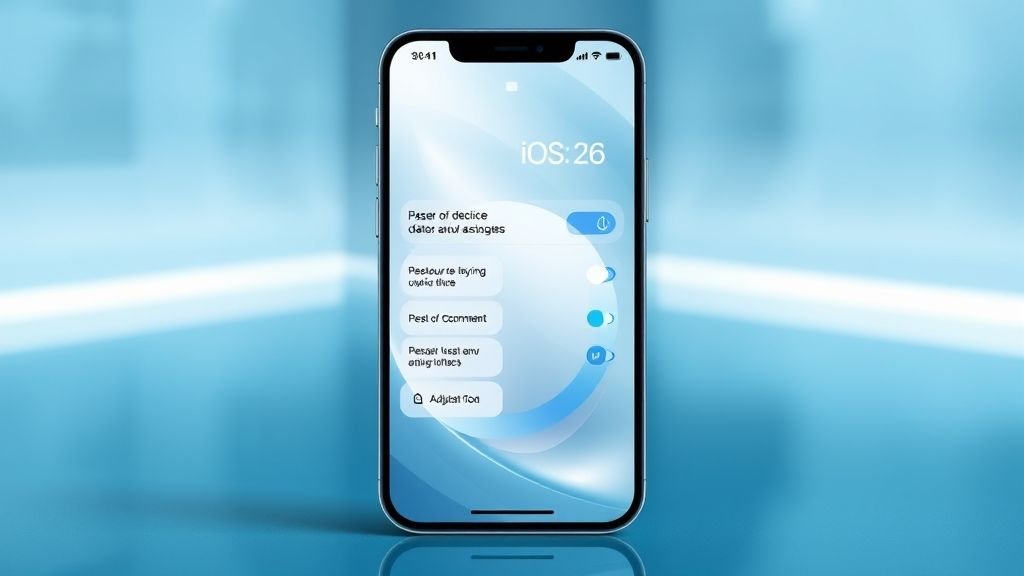Introduction
When Apple first introduced Liquid Glass effects in iOS 26, many users admired its shiny, translucent look. The way apps and menus shimmer and blur creates a modern, sleek feel. However, this beauty often comes with frustrations. The effects can slow down your device, drain the battery faster, and even distract you during use.
For those wanting a faster, more efficient iPhone experience, customizing these visual effects is important. Adjusting settings helps balance eye candy with overall performance. If you’re tired of lag and want your device to run smoother, tweaking Liquid Glass effects is the way to go.
Understanding Liquid Glass Effects in iOS 26
What Are Liquid Glass Effects?
Liquid Glass effects refer to the transparent, blurred backgrounds you see behind menus, notifications, and other interface components. These effects mimic the look of frosted glass—soft, shiny, and reflective. Apple made these features to give iOS a modern, refined style. You’ll notice them in Control Center, app switcher, and even in app backgrounds.
Impact on Device Performance
While pretty, these effects use extra processing power. The CPU and GPU work harder to create smooth animations and reflections. It’s like adding shiny coating to a car—it makes it look good, but can slow down the engine. Many users report lag, jittery screens, and quicker battery drainage after enabling Liquid Glass effects. For older iPhones or devices with less RAM, these effects can cause real slowdowns.

Compatibility and Limitations
Older iPhones, like the iPhone 8 or earlier, tend to struggle more with these visual effects. The hardware simply wasn’t built for such intensive graphics. Users with limited storage or those running customized setups might find it tough to achieve a good balance between beauty and performance. Keep in mind: reducing these effects can help older hardware run faster.
How to Disable or Minimize Liquid Glass Effects
Adjusting Transparency and Motion Settings
The easiest way to cut down on Liquid Glass effects is through Accessibility settings:
- Open Settings.
- Tap Accessibility.
- Select Display & Text Size.
- Turn on Reduce Transparency — this mutes the frosted glass look.
- Go back and choose Motion.
- Toggle on Reduce Motion to limit animations and reflections.
These simple steps drastically cut down visual effects, speeding up your device and saving battery life.
Modifying Developer Options and Using Custom Configurations
For the more tech-savvy, enabling developer options allows deeper customization:
- Enable Developer Mode in the Settings.
- Use configuration profiles to disable or tweak certain visual effects.
- You can find profiles online made specifically for improving performance.
Note: Changing system files or profiles may void warranties or cause issues, so proceed with caution.
Using Third-Party Apps and Jailbreak Tweaks
Some trusted apps claim to optimize performance by disabling animations. Only consider them if you’re comfortable with the risks. Jailbreaking allows total control over effects but exposes your device to security threats and stability problems. If you choose to go down this path, research thoroughly and back up your device first.
Tips for Enhancing Performance While Maintaining Visual Appeal
Optimizing System Settings
- Turn off Background App Refresh to free resources.
- Disable Auto-Downloads for apps, backups, and updates.
- Reduce visual effects via Settings > Accessibility to make interface more responsive.
Keeping iOS and Apps Updated
Apple regularly releases updates that fix bugs and improve performance. Always update to the latest iOS version, especially after a new release like 26, to benefit from fixes and stability improvements.
Managing Storage and Background Processes
- Regularly clear cache and unnecessary files.
- Close apps running in the background.
- Restart your device periodically to keep things running smoothly.
These small steps help prevent overloading your hardware and improve overall speed.
Expert Recommendations and Best Practices
Insights from iOS Developers and Apple Support
Apple suggests balancing visual effects with device performance. They recommend turning off certain features if you experience lag or quick battery drain. The official advice? Use accessibility settings to lessen effects and ensure a smooth experience.
Community Feedback and User Cases
Many users report that disabling transparency and reducing motion make a noticeable difference. Some have even switched to darker wallpapers or minimal themes to decrease the load on their device. The common goal? Keep the shiny effects without sacrificing speed and battery life.
Conclusion
Reducing Liquid Glass effects on iOS 26 is straightforward. Start with accessibility options—turn off transparency and limit motion. For more control, consider tweaking developer settings or using trusted third-party tools. Keeping your system updated and managing storage ensure your device runs smoothly.
Remember: you don’t have to settle for lag or quick battery drain. Customizing visual effects strikes a perfect balance. Make your iPhone faster, more responsive, and tailored to your style by adjusting these settings. Your device will thank you with improved performance and longevity.
